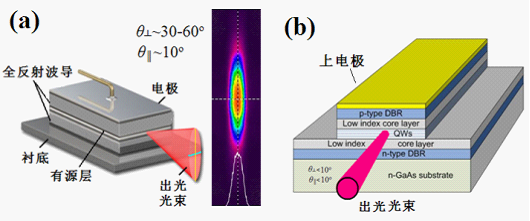Recently, by the Chinese Academy of Sciences Changchun Institute of Optics, Fine Mechanics and Physics, State Key Laboratory of Luminescence and Applications, High-power Semiconductor Lasers Research Group, Zang Cunzhu, Researcher, Chinese Academy of Sciences Knowledge Innovation Project frontier project “High-power high-brightness photonic crystal lasers and arrays†Progressive progress. They succeeded in reducing the divergence angle of the semiconductor laser fast axis (vertical) from 40° to 7.5° and the slow axis (horizontal) divergence angle of 7.2°° through the Bragg reflective waveguide structure to achieve near-circular beam exit.
One of the biggest drawbacks of semiconductor lasers has been their large divergence angle and elliptical light spot, which has resulted in poor beam quality. The quality of the beam reflects the convergence of the laser, directly affecting the practical application. At present, commercialized semiconductor lasers use a total reflection waveguide structure (Fig. 1(a)). The structure of the laser resonator is narrow and asymmetric, resulting in a fast axis divergence angle as high as 30°-60° and a slow axis divergence angle of 10°. .
The research team used a bilateral transverse Bragg reflection waveguide structure (Fig. 1(b)). This structure conducts optical guided waves through the photonic band gap principle. The limited mode is an optical defect mode and can effectively compress the far-field divergence angle of the laser. After successfully solving the problem of photonic crystal defect mode and total reflection mode competition and high-quality thick-scale (>10 micron) epitaxial growth technology, the continuous lasing of the device at room temperature was studied. The device operates at 808nm with an output power of >2W and a slope efficiency of 0.531W/A. The divergence angles of the fast and slow axes are reduced to 7.5° and 7.2°, and the light spot is nearly circular (Figure 2).
This type of device structure can be used not only for quantum well lasers, but also for semiconductor lasers with different wavelengths and different gain media, such as quantum dots, quantum cascade lasers, etc. This can completely change the divergence angle of the semiconductor laser from the perspective of the chip structure. Disadvantages of asymmetry. The core structure of the device has been applied for 4 national invention patents. At present, researchers are seizing the time to optimize the process, further improve the performance of the device, and strive to achieve practical.

Figure 1. (a) Schematic diagram of a semiconductor laser and a typical far-field diagram, and (b) Schematic diagram of a Bragg reflector waveguide laser.

Figure 2. (a) LIV characteristics of an 808 nm Bragg reflector waveguide laser with insets of lasing spectroscopy, (b) far field divergence at 3A operating current, and insets of the measured two-dimensional far-field speckle pattern.
Fruit Bags,Mesh Bags,Vegetable Bags
Metal Wire,Fence,Wire Mesh Co., Ltd. , http://www.nsmeshmetals.com
